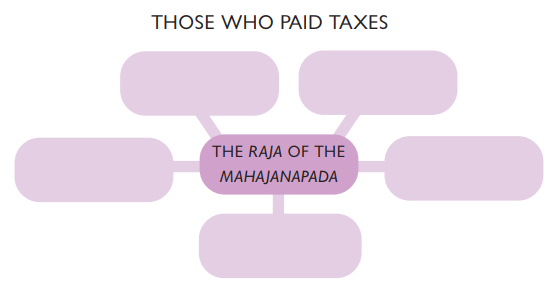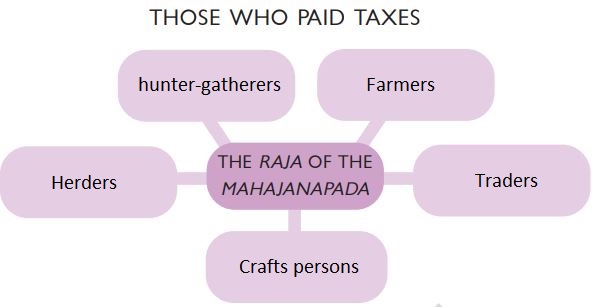History - Class 6
Our Past - I
Chapter 5: Kingdoms, Kings and An Early Republic
Intext Questions:
Question 1. Make a list of all those who would be present at the sacrifice. Which are the categories that are described in terms of their occupation?
Answer: People presented at these rituals were-
- Raja- Rules the kingdom
- Charioteer- rides the chariots
- Priests- perform the rituals
- Vish- ordinary persons
Question 2. Why did people oppose the system of varnas?
Answer: Many people did not accept the system of varna laid down by the brahmins. Some kings thought they were superior to the priests. Others felt that birth could not be a basis for deciding which varna people belonged to. Besides, some people felt that there should be no differences amongst people based on occupation. Others felt that everybody should be able to perform rituals. And others condemned the practice of untouchability. Also, there were many areas in the subcontinent, such as the north-east, where social and economic differences were not very sharp, and where the influence of the priests was limited.
Question 3. Is there a crop in this list that was not mentioned in Chapter 3?
Answer: Sugarcane is the only crop that was not mentioned in chapter 3
Question 4. List two ways in which the rajas of the mahajanapadas were different from those mentioned in the Rigveda.
Answer: The difference between the rajas of mahajanapadas and rigvedic rajas were-
- New rajas now began maintaining armies.
- Soldiers were paid regular salaries and maintained by the king throughout the year. Some payments were probably made using punch marked coins.
- Building huge forts
Question 5. What do you think would have been provided by hunters and gatherers?
Answer: Hunters and gatherers had to provide hunted animals meat, forest produce like honey, nuts like to the raja.
Question 6. Can you think why kings would encourage these changes?
Answer: There were two major changes in agriculture around this time. One was the growing use of iron ploughshares. This meant that heavy, clayey soil could be turned over better than with a wooden ploughshare, so that more grain could be produced. Second, people began transplanting paddy. This meant that instead of scattering seed on the ground, from which plants would sprout, saplings were grown and then planted in the fields. This led to increased production, as many more plants survived.
Question 7. In what ways were these armies different from those described in the Rigveda?
Answer: In the Rigveda times there was no regular army. Most of the man took part in the war, whenever required. In the later period, the king had vast armies of foot soldiers, chariots and elephants.
Question 8. In what ways was the Vajji sangha different from the other mahajanapadas? Try and list at least three differences.
Answer: The difference between the Vajji sangha and mahajanapadas were:
- They held full and frequent public assemblies.
- They met and acted together.
- They followed established rules.
- They respected, supported and listened to elders.
- Vajji women were not held by force or captured.
Question 9. Do you think this was a true democracy?
Answer: It was not a true democracy because women were not considered as citizens. Many foreigners, merchants and crafts persons did not have rights as citizens.
Imagine
Question: You are peeping through a crack in the walls of the assembly of Vaishali, where a meeting is in progress to discuss ways to deal with an attack by the king of Magadha. Describe what you might hear.
Answer: I might have heard the discussions of jana or assembly in Vaishali which is holding a meeting to discuss how to deal with an attack by the king of Magadha.
Let's recall
Question 1.State whether true or false:
- Rajas who let the ashvamedha horse pass through their lands were invited to the sacrifice.
- The charioteer sprinkled sacred water on the king.
- Archaeologists have found palaces in the settlements of the janapadas.
- Pots to store grain were made out of Painted Grey Ware
- Many cities in mahajanapadas were fortified.
Answer:
- True
- False
- False
- False
- True
Question 2. Fill in the chart given below with the terms: hunter gatherers, farmers, traders, crafts persons, herders.

Answer:

Question 3. Who were the groups who could not participate in the assemblies of the ganas?
Answer: The groups who cannot participate in the assemblies of the ganas were:
Women, Shudras, Kammakaras, etc.,.
Let’s discuss
Question 4. Why did the rajas of mahajanapadas build forts?
Answer: The Rajas of mahajanapadas built forts around their capital cities because probably the people were afraid of attacks from other kings and needed protection.
It is also possible that some rajas wanted to show that they were rich and powerful by building large, tall and impressive walls around cities.
The Rajas of mahajanapadas built forts for:
- Their security
- Their show off
- Fortified city was easy to manage
Question 5. In what ways are present-day elections different from the ways in which rulers were chosen in janapadas?
Answer: Choosing rulers in janapadas- men were chosen rajas by performing big sacrifices. The ashvamedha was one such ritual whch was used to identify a raja.
The raja chosen by this sacrifice was considered very powerful. Electing rulers today- Today, we have a democratic system of government. Each citizen has a right to vote and the government is decided by elections in which each citizen has to vote.
Let’s do
Question 6. Were there any janapadas in your state? If yes, name them. If not, name the janapadas that would have been the closest to your state, and mention whether they were to the east, west, north or south.
Answer: Asmaka was the only janapadha in Andhrapradesh. It is in the south india
Question 7. Find out whether any of the groups mentioned in answer 2 pay taxes today.
Answer: Traders, craftsperson pay taxes to the government today.
Question 8. Find out whether the groups mentioned in answer 3 have voting rights at present.
Answer: Women, Shudras, Kammakaras have voting rights now.